There's a root poetry to place. Something slightly more solid than the ephemeral everyday etcetera of existence. Perhaps it is because the land continues on without us, bearing only, if we're lucky, bare bones and tokens. Or perhaps it is because places teach us that we are always, by mere fact of existing, participants in larger, living ecosystems, within myriad circumferences of "where." Even the constant traveler, claiming no home except for the ever shifting road, comes into and out of life at two particular and precise geographical points, the birth place and death place. As such, no creature born into this earth can ever really be uprooted from it: we are all earthlings and universelings. The precise moment that we pour a cup of tea, wherever we are, we are pinning that moment upon the earth, we are drinking in the surroundings, we are creating a moveable tearoom and temple that changes in every new place.
Like any being or story, tea is shaped by the environment. This not only accounts for the variety of tea cultivars and tea characteristics, all of which depend on regional factors for their taste and energy, but the variety of experiences we can have depending on the environment in which we enjoy it. Long Jing does not come from Japan, nor can true Sencha come from China. The mountains that give Taiwanese oolongs their lush floral misty lore are different than those that imbue a similar floral taste into the rolled oolongs of China's Fujian province. In Hawaiian tea, we taste the volcanic soil, the salt air, the minerals. In Pu Er teas, we taste the wild ancient jungles of Xishuangbanna. Beyond these considerations of place which shape the tea itself, we must consider the place where these sacred leaves are infused and imbibed. The same tea is apt to taste different if prepared in different locales, or in different ways. A tea might taste different in the tearoom than it does at home or out on a cha xi adventure. Kakuzō Okakura's seminal text on Japanese tea aesthetics, The Book of Tea (1906), stresses that the setting in which we enjoy tea is almost as important, if not more important, than the tea itself. This refers to both external and internal places or settings: one has to create the proper mindset in order to truly enjoy tea.
This is because we recreate the universe in each Chanoyu: the placement of each instrument is just so. We set flowers to keep alignment between the inner and outer worlds, between self and nature. We consciously recognize that we are all guests and visitors in this transient moment, rooted in a tearoom that is also just a transient moment, made of natural materials that decay over time. The acknowledgement and bowing to place that is so present in the tea ceremony brings an alignment that is so often absent or vastly under-appreciated in our modern Western lives. While we think of ourselves as living in a certain place, most of us do not bow to the land as we once did, centuries ago, consciously appreciating being a part of it, thanking it for its gift of food, or watching the stars change from a fixed spot in order to understand that the earth, like us, is also living as a smaller part of a much larger existence. Without these conscious reminders, we are apt to lose perspective. And without true perspective, we are more apt to hurt each other and the earth.
To better understand the nature of how place and the tea experience are connected, I performed three chanoyu ceremonies, one on a mountaintop, one at a resevoir, and one by an urban waterfall.
Like any being or story, tea is shaped by the environment. This not only accounts for the variety of tea cultivars and tea characteristics, all of which depend on regional factors for their taste and energy, but the variety of experiences we can have depending on the environment in which we enjoy it. Long Jing does not come from Japan, nor can true Sencha come from China. The mountains that give Taiwanese oolongs their lush floral misty lore are different than those that imbue a similar floral taste into the rolled oolongs of China's Fujian province. In Hawaiian tea, we taste the volcanic soil, the salt air, the minerals. In Pu Er teas, we taste the wild ancient jungles of Xishuangbanna. Beyond these considerations of place which shape the tea itself, we must consider the place where these sacred leaves are infused and imbibed. The same tea is apt to taste different if prepared in different locales, or in different ways. A tea might taste different in the tearoom than it does at home or out on a cha xi adventure. Kakuzō Okakura's seminal text on Japanese tea aesthetics, The Book of Tea (1906), stresses that the setting in which we enjoy tea is almost as important, if not more important, than the tea itself. This refers to both external and internal places or settings: one has to create the proper mindset in order to truly enjoy tea.
This is because we recreate the universe in each Chanoyu: the placement of each instrument is just so. We set flowers to keep alignment between the inner and outer worlds, between self and nature. We consciously recognize that we are all guests and visitors in this transient moment, rooted in a tearoom that is also just a transient moment, made of natural materials that decay over time. The acknowledgement and bowing to place that is so present in the tea ceremony brings an alignment that is so often absent or vastly under-appreciated in our modern Western lives. While we think of ourselves as living in a certain place, most of us do not bow to the land as we once did, centuries ago, consciously appreciating being a part of it, thanking it for its gift of food, or watching the stars change from a fixed spot in order to understand that the earth, like us, is also living as a smaller part of a much larger existence. Without these conscious reminders, we are apt to lose perspective. And without true perspective, we are more apt to hurt each other and the earth.
To better understand the nature of how place and the tea experience are connected, I performed three chanoyu ceremonies, one on a mountaintop, one at a resevoir, and one by an urban waterfall.
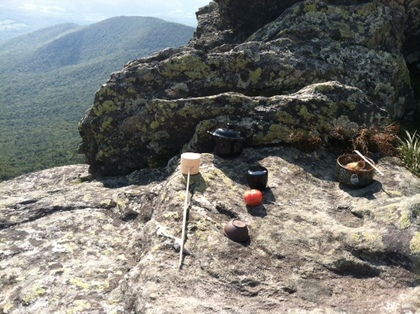
Mountaintop: Dragonesque
These places all have meaning for me, but Camel's Hump has perhaps the deepest root: I have climbed its slopes every year since I was a little girl, and probably also once or twice in utero. When I made this ascent with my tea gear clanking in my backpack, it was one of those saturatingly humid Vermont summer days, and by the time I reached the top I was absolutely breathless, and not just because of the breathtaking views. With gummy legs and spiraling head, I tried to find a flat spot for chanoyu that was not too close to the edge but away from the crowd--though the second highest peak in Vermont, Camel's Hump may well be the most popular mountain, and there were several people at the summit.
There, at the edge of the mountain, where I could feel the humid landscape spiraling beneath me, the tea experience was one that I might describe as "dragonesque." After only one sip, I was flying! The force of the earth, the power of the winds, and the sheer vertiginous feeling combined to make my frothy green cup a sort of anchor, but an anchor into the air, an anchor into the feeling of powerful flight. The rocks' lichen were the same color as the tea, and the neighboring peaks seemed to be heaped in the powdery green goodness, an external reflection of the beautiful heaps of matcha in the natsume. Even with the sparse and rather uneven placement of the utensils, with the winds tearing at the fukusa and spinning the chashaku, this ceremony remains singular in my mind as one of the most utterly shamanic tea experiences I've ever had.
These places all have meaning for me, but Camel's Hump has perhaps the deepest root: I have climbed its slopes every year since I was a little girl, and probably also once or twice in utero. When I made this ascent with my tea gear clanking in my backpack, it was one of those saturatingly humid Vermont summer days, and by the time I reached the top I was absolutely breathless, and not just because of the breathtaking views. With gummy legs and spiraling head, I tried to find a flat spot for chanoyu that was not too close to the edge but away from the crowd--though the second highest peak in Vermont, Camel's Hump may well be the most popular mountain, and there were several people at the summit.
There, at the edge of the mountain, where I could feel the humid landscape spiraling beneath me, the tea experience was one that I might describe as "dragonesque." After only one sip, I was flying! The force of the earth, the power of the winds, and the sheer vertiginous feeling combined to make my frothy green cup a sort of anchor, but an anchor into the air, an anchor into the feeling of powerful flight. The rocks' lichen were the same color as the tea, and the neighboring peaks seemed to be heaped in the powdery green goodness, an external reflection of the beautiful heaps of matcha in the natsume. Even with the sparse and rather uneven placement of the utensils, with the winds tearing at the fukusa and spinning the chashaku, this ceremony remains singular in my mind as one of the most utterly shamanic tea experiences I've ever had.

Reservoir: Liquid Heart
I spent almost every day of last summer at Essex's Indian Brook Reservoir, and, as such, it became my "go to" spot for a quick dip, or a long dreamy sunny sojourn. The waters here are very clean, and always seem to be at a perfect temperature, and it's easy for a good swimmer to swim across the reservoir to the rocks and outcroppings on the other side and back. I remember one day approaching dusk, I sat quietly, overhanging my feet off a rock and into the waters. I was singing softly. Slowly, several (at least ten) rainbow trout began to approach my feet and started giving them soft bites and nips, thinking they were food. It tickled. I would have been able to easily snatch one up for dinner, if I weren't vegan: the fish got lucky that day.
Setting up for the simple ceremony was easy here. I created a flat surface with the help of a lovely granite stone, and the raging winds of the mountaintop were now but mere zephyrs. As expected, my chanoyu experience was deeply nourishing and peaceful in this place. The emerald brew in the chawan seemed to ripple with a sweetness matched by the lovely Indian Brook waters, as if they were part of the same essence, and I was drinking from the reservoir itself. My body felt at ease and relaxed from my frolicksome hours of swimming in which I had just indulged, and the tea imparted a sort of dreaminess, a gentleness inviting me into a more subtle awareness, a more still presence. Just as all summer I dove into the clear waters and felt them fill my soul up with the blessing of water, of purification and peace, I felt this bowl of matcha fill me up with a liquid-hearted nurturing, a green surrender to peace.
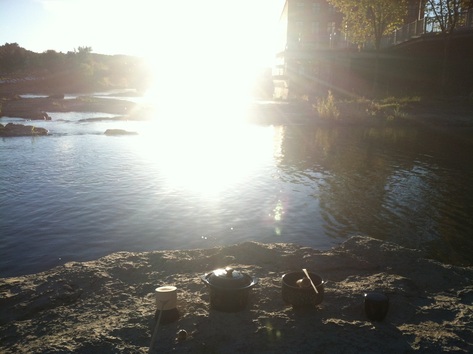
Waterfall:
Ebullience Centered
The Winooski river is a sacred river. Once, the Abenaki people had a thriving settlement, named for the wild onions that grew along the banks. This is why Winooski is called "Onion River City." In the fertile river valley just below these cascades, in the flood plains of the Intervale, modern farmers benefit from the same flow of the river's water. However, the waters have not always been beneficent: in the flood of 1927, the waters here rose so high that they obliterated the bridge, ravaged the entire first floor of the woolen mill, and killed 55 people.
For nearly five years I have lived in an apartment only a few streets away from these captivating cascades, and have been blessed to watch the changes in the mighty waterfall's flow through the seasons. In the winter, the ice and snow make long white canyons through which the ever flowing waters glisten. In the spring, they are furious and terrifying in their bursting forth. And in the summer, their mellifluous tumbling fills the spirit with a soft laughter and a sense that all things pass into radiance.
In the full swing of summer, I never let a sunset go by without taking time to soak in some sun, and the Winooski shines with a passion during these golden hours before dusk. Sweetly, on one of the flat rocks that jut out into its upper rapids, I laid out my wares, without worrying too much about what the Winooski residents along the banks would think of this ritual equipment. I began, and felt a centering, much like the way one senses the sun from closed eyes: a warm knowing, an inner reflection. The little splashes of spray from the falls tickled me as I performed the ceremony, like wee waterfall sprites come to join in the jade green goodness. Perhaps it was the musky aroma of the water reeds and river muck, but there was something more "alive" to this bowl of matcha: something was moving, changing, growing in the whisked broth. A flow from stagnant water to bubbling rapids and transformed into pure joy. As I tasted the fern-green infusion, surrounded on all sides by merry swirls and eddies, I felt the ebullience heightened by this act of centering, the taste more sparkly and yet simultaneously more like a rich verduous silt. The sun almost setting, the air the perfect temperature for my skin, I sighed into the paradoxical presence of river wisdom: so close to home, so dear to my heart, so clear in its direction, and yet always different, always changing. The waterfall is a macrocosmic manifestaion of the step in which we let water tumble down from wooden ladle (hishaku) into the chawan, an act of honoring gravity, honoring the way that water descends to fill whatever form it is given. When water falls, whether in rapids or rain, flowers and onions grow.
************
I invite you to taste the different places in tea, and taste teas in different places. Before you drink your next cup of tea, be aware of where you are: take note of how the tea cup sits upon the table, the table upon the floor, the floor upon the earth, the earth upon the stars. What are the smells and sounds and thoughts and presences that are being invited into the tea cup, invited into this moment of tea and being? Imagine all the places that come together into the singular first sip: far off mountainsides full of fog, rivers which fed the clouds which fed the leaves, cliffs, terraces, way-stations where the tea stopped over as it was being shipped, a small village, a huge tea factory, all the places visited by the mind as you sip, memories, visions, places real and imagined and the lack of difference between them, landscapes of our emotions, corners of the inner world, tea shrines of the heart and soul. If our minds and hearts can stretch enough, seeing further and further connections of "this place" to all places, and all place, we can realize that all of existence resides in the cup we hold in our hands.
We can't always make it to a mountaintop, waterfall, or reservoir, though we can invoke these beautiful places in our imaginations. But rather than trying to be somewhere else, perhaps there are gifts all around us, right here, waiting to be recognized, no matter where we are. Notice. The deeper we connect to where we are, the more we can see how much we all belong to this moment, this lifetime, this universe, this place.
Ebullience Centered
The Winooski river is a sacred river. Once, the Abenaki people had a thriving settlement, named for the wild onions that grew along the banks. This is why Winooski is called "Onion River City." In the fertile river valley just below these cascades, in the flood plains of the Intervale, modern farmers benefit from the same flow of the river's water. However, the waters have not always been beneficent: in the flood of 1927, the waters here rose so high that they obliterated the bridge, ravaged the entire first floor of the woolen mill, and killed 55 people.
For nearly five years I have lived in an apartment only a few streets away from these captivating cascades, and have been blessed to watch the changes in the mighty waterfall's flow through the seasons. In the winter, the ice and snow make long white canyons through which the ever flowing waters glisten. In the spring, they are furious and terrifying in their bursting forth. And in the summer, their mellifluous tumbling fills the spirit with a soft laughter and a sense that all things pass into radiance.
In the full swing of summer, I never let a sunset go by without taking time to soak in some sun, and the Winooski shines with a passion during these golden hours before dusk. Sweetly, on one of the flat rocks that jut out into its upper rapids, I laid out my wares, without worrying too much about what the Winooski residents along the banks would think of this ritual equipment. I began, and felt a centering, much like the way one senses the sun from closed eyes: a warm knowing, an inner reflection. The little splashes of spray from the falls tickled me as I performed the ceremony, like wee waterfall sprites come to join in the jade green goodness. Perhaps it was the musky aroma of the water reeds and river muck, but there was something more "alive" to this bowl of matcha: something was moving, changing, growing in the whisked broth. A flow from stagnant water to bubbling rapids and transformed into pure joy. As I tasted the fern-green infusion, surrounded on all sides by merry swirls and eddies, I felt the ebullience heightened by this act of centering, the taste more sparkly and yet simultaneously more like a rich verduous silt. The sun almost setting, the air the perfect temperature for my skin, I sighed into the paradoxical presence of river wisdom: so close to home, so dear to my heart, so clear in its direction, and yet always different, always changing. The waterfall is a macrocosmic manifestaion of the step in which we let water tumble down from wooden ladle (hishaku) into the chawan, an act of honoring gravity, honoring the way that water descends to fill whatever form it is given. When water falls, whether in rapids or rain, flowers and onions grow.
************
I invite you to taste the different places in tea, and taste teas in different places. Before you drink your next cup of tea, be aware of where you are: take note of how the tea cup sits upon the table, the table upon the floor, the floor upon the earth, the earth upon the stars. What are the smells and sounds and thoughts and presences that are being invited into the tea cup, invited into this moment of tea and being? Imagine all the places that come together into the singular first sip: far off mountainsides full of fog, rivers which fed the clouds which fed the leaves, cliffs, terraces, way-stations where the tea stopped over as it was being shipped, a small village, a huge tea factory, all the places visited by the mind as you sip, memories, visions, places real and imagined and the lack of difference between them, landscapes of our emotions, corners of the inner world, tea shrines of the heart and soul. If our minds and hearts can stretch enough, seeing further and further connections of "this place" to all places, and all place, we can realize that all of existence resides in the cup we hold in our hands.
We can't always make it to a mountaintop, waterfall, or reservoir, though we can invoke these beautiful places in our imaginations. But rather than trying to be somewhere else, perhaps there are gifts all around us, right here, waiting to be recognized, no matter where we are. Notice. The deeper we connect to where we are, the more we can see how much we all belong to this moment, this lifetime, this universe, this place.
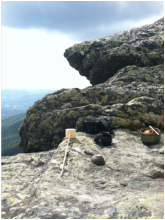

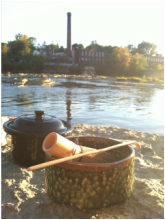
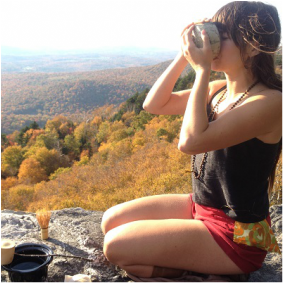
 RSS Feed
RSS Feed
